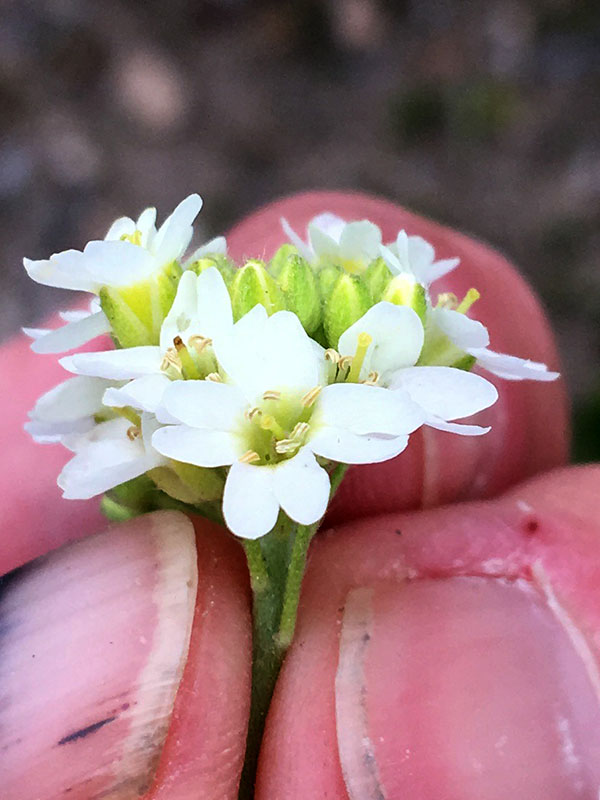Beteroa incana / hoary alyssum
- dense clusters of teeny white flowers
- 4 petals, each with a notch
- fruit is a short, fat-ish seed pod (silicle)
- found in pastures and all manner of disturbed habitats
- toxic to horses
Also known as: false hoary madwort, hoary berteroa, hoary alison
Of all the Brassicaceae in the Valley, hoary alyssum may be one of the more attractive. Although the individual, 4-notched-petaled flowers are teeny, they occur in dense clusters (racemes) making the whole plant rather showy. Indeed, it has been used in ornamental plantings and to cover waste ground. That’s cool, but not so much in the horse country – the plants are toxic to horses.
Hoary alyssum is a biennial herb, and like other species with this life history strategy, it has also been called an annual or short-lived perennial. This all really depends on when a seed germinates and establishes, and on what the moisture supply is like after that. The rosette leaves produced initially are hairy and grayish, due to the presence of stellate (star shaped) trichomes.
Once a plant bolts, the leaves and stems are also hairy, but perhaps not as much so. Hoary alyssum starts flowering either soon after germination or in early spring the following year, and it reproduces continuously until it freezes. The fruit is a hairy silicle (a short, fat silique/seed pod) up to a half inch long and over a growing season, individual plants can yield up to 5000 seeds.
Hoary alyssum is an aggressively invasive species of roadsides, farms, pastures, riverbanks, construction sites, wastelands, overgrazed rangelands, and lawns. It doesn’t ‘t mind the cold winters in the Valley or hot, dry summer conditions. Like other drought tolerant plants, it has a deep taproot. Poor soils are its cup of tea, especially with sand and gravel, and high pH, high calcium soils are no problem for it.
But… the plants are toxic to horses (although not generally fatal). The animals can (and do) avoid it in the field, but not in cut hay. There are more signs of poisoning than you can shake a stick at, including lameness and leg edema, stiffness, fever, diarrhea, intravascular hemolysis, hypovolemic shock, premature birth, abortion, gut ulceration, edema of the kidneys, pulmonary edema, and calcium crystals in the urine. (Wikipedia).
For cattle, sheep and goats, while it is not toxic, it has poor nutrient quality. If enough of it contaminates alfalfa or clover hay, it reduces its quality as well. Nevertheless, there has been some success using goats to control hoary alyssum in pastures.
| Color | |
|---|---|
| Family | |
| Blossom size | |
| Inflorescence size | |
| Inflorescence type | |
| When? | |
| Where? |



